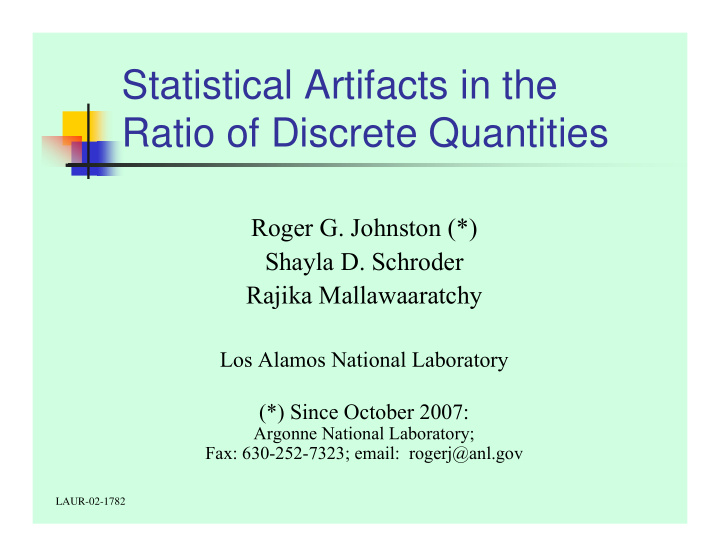



Statistical Artifacts in the Ratio of Discrete Quantities Roger G. Johnston (*) Shayla D. Schroder Rajika Mallawaaratchy Los Alamos National Laboratory (*) Since October 2007: Argonne National Laboratory; Fax: 630-252-7323; email: rogerj@anl.gov LAUR-02-1782
Common Problems in Using the Ratio � Choosing units poorly � Keeping wrong number of digits � Ignoring covariance in error analysis � Undefined when denominator = 0
Common Problems in Using the Ratio (con’t) These problems are fairly well recognized (except by students), but two others aren’t...
Other Problems with the Ratio (Less Widely Recognized) � Artifacts in the ratio when the numerator & denominator are discrete � Lexicon
The Statistical Artifact � Weird fine-structure (sometimes not so fine) shows up in the histogram of the ratio of two discrete variables. � This can, and often has, been misinterpreted as instrumentation problems, or as potentially interesting science or engineering. � But it really is an artifact of ratioing discrete numbers. � Yet the artifact is not a binning error!
Batting Average: an instructive example BA = number of hits number of at bats .000 ≤ BA ≤ 1.000 (1001 possible batting averages)
Batting Average (con’t) Batting .333 is “easy”. I can go: 1 for 3, 2 for 6, 3 for 9, ... but Batting .334 is difficult! I must go: 96 for 287, 97 for 290, 98 for 293, ...
Batting Average (con’t ) Many players don’t get 287 official at bats in an entire season, so they never even get a shot at batting .334! (Thus, .334 is nearly unobtainable.)
Just to be Specific... Consider the ratio R=A/B where A & B are: • integers in the range 0-255 • uncorrelated • given by a Gaussian probability distribution with mean=127.5, s=32 and R values are: • in the range 0-5 • digitized (quantized) over 256 values (channels or bins)
What Does the Ratio Histogram Look Like? A: integers, 0-255 (256 bins = 8 bit resolution) B: integers, 0-255 (256 bins = 8 bit resolution) R=ratio=A/B: 0-5 in 256 bins (8-bit resolution)
The Artifact Gets Worse With Higher Histogram Resolution! A: integers, 0-255 (256 bins = 8 bit resolution) B: integers, 0-255 (256 bins = 8 bit resolution) R=ratio=A/B: 0-5 in 1024 bins (10-bit resolution)
Thus, the Artifact is Not Due to Binning Errors! With higher resolution for the ratio, the histogram artifact gets worse, not better. Why? Because there are more nearly unobtainable “batting averages”
Artifacts in the Ratio Histogram How bad can it get?
Artifacts in the Ratio Histogram (con’t) A: integers, 0-9 B: integers, 0-9 R=ratio=A/B: 0-5 in 100 bins
Artifacts in the Ratio Histogram (con’t) So how CAN we reduce the artifact?
Artifacts in the Ratio Histogram (con’t) A: integers, 0-99 (100 bins) B: integers, 0-99 (100 bins) R=ratio=A/B: 0-5 in 1000 bins
More Bins for A & B Reduces the Artifactual Fine Structure! A: integers, 0-999 (1000 bins) B: integers, 0-999 (1000 bins) R=ratio=A/B: 0-5 in 1000 bins
Artifacts in the Ratio Histogram (con’t) But is it just a matter of oscillating high and low values in adjacent bins ?
Runs are Possible! A: integers, 0-73 B: integers, 0-108 R=ratio=A/B: 0-5 in 264 bins
Getting Fooled By the Statistical Artifact But is the statistical artifact in the ratio REALLY a problem?
Getting Fooled By the Statistical Artifact (con’t) Yes! We’re aware of 7 examples at Los Alamos National Laboratory of the artifact fooling scientists, engineers, or technicians.
Getting Fooled By the Statistical Artifact -- example 1 Application data acquisition software Artifact Misinterpreted As software bug
Getting Fooled By the Statistical Artifact -- example 2 Application analog-to-digital converter electronics Artifact Misinterpreted As electronic noise
Getting Fooled By the Statistical Artifact -- example 3 Application image processing (ratio of one image to another) Artifact Misinterpreted As video noise
Getting Fooled By the Statistical Artifact -- example 4 Application computer modeling Artifact Misinterpreted As numeric non-convergence
Getting Fooled By the Statistical Artifact -- example 5 Application light scattering (normalizing to laser intensity) Artifact Misinterpreted As instrument problems
Getting Fooled By the Statistical Artifact -- example 6 Application fluorescence from biological cells during flow cytometry Artifact Misinterpreted As a new subset population of cells
Getting Fooled By the Statistical Artifact -- example 7 Application finding data outliers Artifact Misinterpreted As excessive number of outliers
Recommendations for Not Getting Fooled by the Artifact Use the highest practical resolution (lots of • bits) for the numerator & denominator but the lowest practical resolution for the ratio. • Add a small amount of real random noise to the numerator and/or denominator.
Recommendations for Not Getting Fooled by the Artifact (con’t) Smooth the ratio histogram • Use analog electronics to measure the analog ratio • of the numerator & denominator before digitizing. Model the artifact •
Recommendations for Not Getting Fooled by the Artifact (con’t) If nothing else, at least be aware of the artifact so as • not to get fooled!
Lexicon Problems If you believe the Dictionary (usually a bad idea), then “ratio” is only a noun. Thus, these statements are not allowed: “We are going to ratio 2 numbers.” (verb) “The artifact shows up during ratioing.” (gerund) “I promise to never get fooled again by the ratioing (or ratio) process.” (adjective)
Lexicon Problems (con’t) But the only important test of the appropriateness of a given (non-obscene) word or phrase in English is: (1) is it unambiguous? and (2) is it concise? Thus, we should surely allow “ratio” to be used as a verb, gerund, and adjective (not just as a noun) as is the case with many words in English and most technical words!
References • Roger G. Johnston, Shayla D. Schroder, and A. Rajika Mallawaaratchy, “Statistical Artifacts in the Ratio of Discrete Quantities”, American Statistician 49, 285-291 (1995). • Comments by Cornel G. Ormsby and Reply by Roger G. Johnston, American Statistician 50, 281 (1996). • Argonne National Laboratory Vulnerability Assessment Team Home Page: http://www.ne.anl.gov/capabilities/vat/ (since October 2007)
Recommend
More recommend